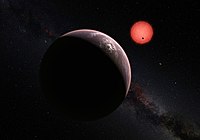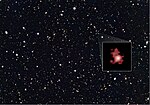astro.wikisort.org - Meteorite
TRAPPIST-1b, also designated as 2MASS J23062928-0502285 b, is a mainly rocky, Venus-like exoplanet orbiting around the ultra-cool dwarf star TRAPPIST-1, located approximately 40 light-years (12 parsecs) away from Earth in the constellation of Aquarius. The planet was detected using the transit method, where a planet dims the host star's light as it passes in front of it. It was first announced on May 2, 2016, and between 2017 and 2018, more studies were able to refine its physical parameters.
 Artist's impression of TRAPPIST-1b (February 2018) | |
| Discovery | |
|---|---|
| Discovery date | May 2, 2016 |
Detection method | Transit |
| Orbital characteristics | |
| Apastron | 0.01162 + 0.0000031–0.000004 AU (1,738,330 + 460–600 km) |
| Periastron | 0.011476 + 0.0000034–0.000004 AU (1,716,790 + 510–600 km) |
Semi-major axis | 0.01154775 ± 5.7×10−08 AU (1.7275188×106 ± 8.5 km)[1] |
| Eccentricity | 0.00622 (± 0.000304)[1] |
Orbital period (sidereal) | 1.51087637 ± 0.00000039 d (36.2610329 ± 9.4×10−6 h; 130,539.718 ± 0.034 s)[2] |
| Inclination | 89.56 (± 0.23)[2] |
| Star | TRAPPIST-1[3] |
| Physical characteristics | |
Mean radius | 1.121 +0.031 −0.032[1] REarth |
| Mass | 1.017 +0.154 −0.143[1] MEarth |
Mean density | 3.98 + 0.51–0.50 g/cm3 (2.30 + 0.29–0.29 oz/cu in) |
Surface gravity | 0.812 +0.104 −0.102[1] g |
| Temperature | 391.8 ± 5.5 K (118.65 ± 5.50 °C; 245.57 ± 9.90 °F) (equilibrium)[2] ≥1,400 K (1,130 °C; 2,060 °F) (atmosphere)[2] 750–1,500 K (477–1,227 °C; 890–2,240 °F) (surface)[1] |
The planet is about the same mass as Earth but about 12% larger. Its relatively low density, along with spectroscopic observations, has confirmed an extremely thick and hot atmosphere. Observations published in 2018 showed that the atmosphere of TRAPPIST-1b was much larger than that of Earth or Venus, as well as being very hot and potentially rich in CO2.[2] More recent modeling studies have suggested the planet is too hot to allow the formation of sulfuric acid clouds, such as are found on Venus, the hottest planet in our solar system.[4]
Physical characteristics
Mass, radius, and temperature
TRAPPIST-1b is very similar in both mass, radius, and gravity to Earth. It has a radius of 1.121 REarth, a mass of 1.02 MEarth, and about 81% Earth's surface gravity. However, the density of the planet indicates that it is not entirely rocky. With a density of 3.98 g/cm3, about ≤5% of its mass must be volatiles, likely in the form of a thick Venus-like atmosphere due to it receiving nearly four times more energy than Earth does. The planet's surface temperature is estimated to be between 750 K (477 °C; 890 °F) and 1,500 K (1,230 °C; 2,240 °F), potentially as high as 2,000 K (1,730 °C; 3,140 °F). This is much hotter than the surface of Venus and may be hot enough that the surface is molten lava.[1] In addition, the planet should be very geologically active due to tidal squeezing similar to Jupiter's moon Io (see TRAPPIST-1#Resonance for references).
Orbit
TRAPPIST-1b orbits very close to its parent star. One orbit requires only 36 hours, or about 1.51 Earth days.[2] It orbits about 0.0115 AU (1.72 million km; 1.07 million mi) from its star, just 1.2% the distance between Earth and the Sun.[1] The close proximity to its host star means that TRAPPIST-1b is likely tidally locked. It also has a very circular orbit, with an eccentricity of 0.00622, significantly more circular than Earth's orbit.
Host star
TRAPPIST-1b orbits the ultracool dwarf star TRAPPIST-1. It has a mass of 0.089 M☉ and is only 0.121 R☉, with a surface temperature of 2,511 K (2,238 °C; 4,060 °F) and an age between 3 and 8 billion years. The Sun, in comparison, has a surface temperature of 5,778 K (5,505 °C; 9,941 °F) and is about 4.5 billion years old. TRAPPIST-1 is also very dim, with a luminosity about 0.0005 times that of the Sun. It is too faint to be seen with the naked eye, having an apparent magnitude of 18.80.
Atmosphere
The combined transmission spectra of TRAPPIST-1 b and c rule out cloud-free hydrogen-dominated atmospheres for both planets, so they are unlikely to harbor extended gas envelopes. Also, no helium emission from TRAPPIST-1b has been detected.[5] Other atmospheres, from a cloud-free water-vapor atmosphere to a Venus-like atmosphere, remain consistent with the featureless spectra.[6]
In 2018, the planet's atmosphere was better examined by the Spitzer Space Telescope and found to be quite large and hot. The planet's transmission spectrum and refined density estimate suggest two main possibilities for the atmosphere: one rich in carbon dioxide, and one rich in water vapor. The more likely CO2 atmosphere would have a scale height of approximately 52 kilometers (32 miles) (Earth's being 8 km (5.0 mi), and Venus' at 15.9 km (9.9 mi)) and an average temperature in excess of 1,400 K (1,130 °C; 2,060 °F), far greater than its equilibrium temperature of 391.8 K (118.7 °C; 245.6 °F). A water vapor atmosphere would need to have a scale height of >100 km (62 mi) and a temperature >1,800 K (1,530 °C; 2,780 °F) to produce the variations seen in the planet's transit depths and its transmission spectrum, and would be vulnerable to photodissociation where CO2 would not be. Other sources for the effects seen, such as hazes and thick clouds, would require an even larger atmosphere. TRAPPIST-1b will have to be studied further to confirm its potential large atmosphere.[2][1]
Gallery
- Artist's view of planets transiting red dwarf star in TRAPPIST-1 system[7]
- The Sun and the ultracool dwarf star TRAPPIST-1 to scale. The faint star has only 11% of the diameter of the Sun and is much redder in colour.
- Artist's impression of three of the planets (b, c, and d) orbiting TRAPPIST-1
- Artist’s impression video, near one of the three planets orbiting TRAPPIST-1. One of the inner planets is shown in transit across the disc of its tiny and dim parent star.
See also
- 55 Cancri e, another very hot planet with a confirmed atmosphere.
References
- Grimm, Simon L.; Demory, Brice-Olivier; Gillon, Michael; Dorn, Caroline; Agol, Eric; Burdanov, Artem; Delrez, Laetitia; Sestovic, Marko; Triaud, Amaury H.M.J.; Turbet, Martin; Bolmont, Emeline; Caldas, Anthony; de Wit, Julien; Jehin, Emmanuel; Leconte, Jeremy; Raymond, Sean N.; Van Grootel, Valerie; Burgasser, Adam J.; Carey, Sean; Fabrycky, Daniel; Heng, Kevin; Hernandez, David M.; Ingalls, James G.; Lederer, Susan; Selsis, Franck; Queloz, Didier (2018). "The nature of the TRAPPIST-1 exoplanets". Astronomy & Astrophysics. 613: A68. arXiv:1802.01377. Bibcode:2018A&A...613A..68G. doi:10.1051/0004-6361/201732233.
- Delrez, Laetitia; Gillon, Michael; H.M.J, Amaury; Brice-Oliver Demory, Triaud; de Wit, Julien; Ingalls, James; Agol, Eric; Bolmont, Emeline; Burdanov, Artem; Burgasser, Adam J.; Carey, Sean J.; Jehin, Emmanuel; Leconte, Jeremy; Lederer, Susan; Queloz, Didier; Selsis, Franck; Grootel, Valerie Van (2018). "Early 2017 observations of TRAPPIST-1 with Spitzer". Monthly Notices of the Royal Astronomical Society. 475 (3): 3577–3597. arXiv:1801.02554. Bibcode:2018MNRAS.475.3577D. doi:10.1093/mnras/sty051.
- Van Grootel, Valerie; Fernandes, Catarina S.; Gillon, Michaël; Jehin, Emmanuel; Scuflaire, Richard; et al. (2018). "Stellar parameters for TRAPPIST-1". The Astrophysical Journal. 853: 30. arXiv:1712.01911. Bibcode:2018ApJ...853...30V. doi:10.3847/1538-4357/aaa023.
- University of Washington (21 November 2018). "Study brings new climate models of small star TRAPPIST 1's seven intriguing worlds". EurekAlert!. Retrieved 22 November 2018.
- Non-detection of Helium in the upper atmospheres of TRAPPIST-1b, e and f, 2021, arXiv:2106.11444
- de Wit, Julien; et al. (2016). "A combined transmission spectrum of the Earth-sized exoplanets TRAPPIST-1 b and c". Nature. 537 (7618): 69–72. arXiv:1606.01103. Bibcode:2016Natur.537...69D. doi:10.1038/nature18641. PMID 27437572.
- "Artist's view of planets transiting red dwarf star in TRAPPIST-1 system". www.spacetelescope.org. Retrieved 21 July 2016.
На других языках
- [en] TRAPPIST-1b
[es] TRAPPIST-1b
TRAPPIST-1b es un planeta extrasolar (también llamado exoplaneta) que forma parte de un sistema planetario formado por al menos siete planetas.[1] Orbita la estrella enana ultrafría denominada TRAPPIST-1 aproximadamente a 40 años luz en la constelación de acuario. Fue descubierto en el año 2016 por el telescopio TRAPPIST mediante el tránsito astronómico.[2][ru] TRAPPIST-1 b
TRAPPIST-1 b — экзопланета у звезды TRAPPIST-1 в созвездии Водолея, имеющая размер, близкий к размеру Земли. Ближайшая к звезде из семи планет в системе. Открыта 2 мая 2016 года с помощью телескопа TRAPPIST вместе с планетами TRAPPIST-1 c и TRAPPIST-1 d[1][2][3]. Параметры были уточнены на пресс-конференции NASA 22 февраля, на которой также сообщили об обнаружении планет e, f, g и h[4][5][6], а также после публикации данных, собранных телескопом «Кеплер»[7].Другой контент может иметь иную лицензию. Перед использованием материалов сайта WikiSort.org внимательно изучите правила лицензирования конкретных элементов наполнения сайта.
WikiSort.org - проект по пересортировке и дополнению контента Википедии
![Artist's view of planets transiting red dwarf star in TRAPPIST-1 system[7]](http://upload.wikimedia.org/wikipedia/commons/thumb/5/50/Artist%27s_view_of_planets_transiting_red_dwarf_star_in_TRAPPIST-1_system.jpg/200px-Artist%27s_view_of_planets_transiting_red_dwarf_star_in_TRAPPIST-1_system.jpg)






